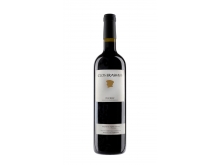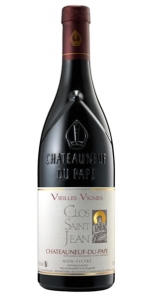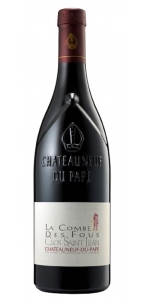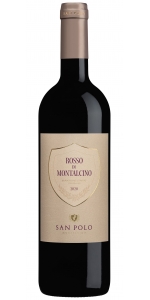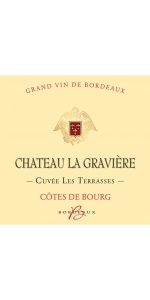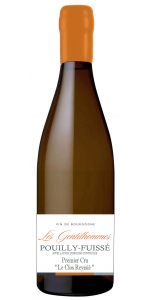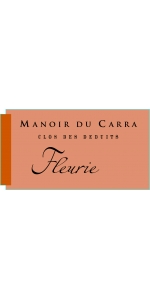Clos i Terrasses Clos Erasmus 2021
3 bottles with free shipping for: $870.00
6 bottles with free shipping for: $1,650.00
12 bottles with free shipping for: $3,120.00
| BUY MORE! SAVE MORE! | ||||||||||||||||||||
|
| Country: | Spain |
| Region: | Priorat |
| Winery: | Clos i Terrasses |
| Grape Types: | Grenache Syrah |
| Organic: | Yes |
| Vintage: | 2021 |
| Bottle Size: | 750 ml |
This wine is one of the absolute benchmarks for fine Priorat, and a reference in Spain. Sourced from 3 small vineyards in the Gratallops, this blend of Grenache and Syrah undergoes strict berry selection and is fermented and aged for 20 months in barrels and amphorae. It is all about dense fruit, exotic spice and licorella minerality, with a freshness and elegance are truly singular, even among the top wines of the appellation.
Review:
A complex bouquet that develops with a little time in the glass from fresh wild berry notes to floral and savoury-herbal nuances with violets and dried thyme. Extremely elegant on the palate, intense yet light-footed and vibrant, with fine-grained, perfect tannins and a long mineral, ethereal and savoury finish.
-Falstaff 100 Points
The 2021 Clos Erasmus is not a shy wine and comes in at 15% alcohol but with a pH of 3.3. The search here is for balance, as power comes as a given in Priorat. It was produced with 70% Garnacha and 30% Syrah, mostly from 40-year-old vines, except for a small plot of around 85-year-old vines. The vineyards are certified organic, and they've practiced biodynamics since 2004 but never got certification. The vinification is simple and the same as for Laurel: the bunches cooled down for 24 hours before being sorted and destemmed, then the grapes were put into the vat, where they warm up and start fermenting with the indigenous yeasts. It was pressed and put in barrels, 40% of them new, where it underwent malolactic and aged for 18 months. It feels like the most elegant and ethereal Erasmus ever despite the 15% alcohol on the label. It's very young and feels a bit shy, slightly developing notes of Mediterranean herbs, wild berries and flowers and is a little closed but very harmonious and insinuating. It's medium to full-bodied, with very fine and elegant but abundant tannins. It does feel lighter than previous vintages, possibly the effect of the cooler year. 3,400 bottles produced. It was bottled in May 2023.
-Robert Parker 99 Points
Folly takes many forms. Driven by whim, restlessness, or passion, it typically marks a pivot in one’s life that only the benefit of hindsight can judge. In 1988 Daphne Glorian spent her entire life’s savings on 17 terraces of vines situated in a wooded hollow just outside the village of Gratallops. Her accomplices in this folly? – René Barbier, Álvaro Palacios, Carles Pastrana, and Josep Lluís Pérez. Together they pooled their resources and newly-acquired vineyards, settling in a region rich in history but without a reputation for fine wines.
In 1989 the modern Priorat was born: one wine but five different labels, each of which would become known worldwide: Clos Mogador, Clos Dofi, Clos Martinet, Clos de l’Obac, and Clos Erasmus. Clos Erasmus is fittingly named after the famed humanist and Renaissance author Desiderius Erasmus, a favorite writer of Daphne and her humanist father, and in whose timeless work – In Praise of Folly – can Daphne’s hard work in the Priorat be fully understood.
Born in Paris but of Swiss-German ancestry, Daphne Glorian spent her early years shuttling between Switzerland and France before settling in Gratallops. “I like to make lists of what needs to be done each day, and in Spain, I’m happy if I manage a quarter of it,” is how Daphne explains her life now in Spain.
While studying law in Paris in her 20s, Daphne first discovered fine wine while working as the office manager for Kit Stevens MW. What was simply a job to make ends meet would soon become her advocation. Shortly after taking the job with Kit, she met René Barbier and Álvaro Palacios, who were both so passionate about a place called the Priorat that she decided she needed to visit and see it for herself.
The early years of making wine in the Priorat were not easy. The rugged landscape and poor soils yielded only small quantities of wine, and the region was unknown outside of Catalunya. From its start, Clos Erasmus has been a wine made from younger vines blessed with being planted in the right spot. Farming has always been sustainable, and with the addition of Ester Nin as Daphne’s viticulturist in 2004, Clos i Terrasses has been converted to biodynamic farming.
In her early vintages, Daphne relied on her friends René Barbier and Álvaro Palacios for advice, but guided by her instincts and her training in Burgundy, where she first discovered wine, her wines have evolved to become some of the most sought-after references for the Priorat – and along the way, some of the most desired wines in the world. Despite having received multiple 100-point scores from top critics, Daphne has kept Clos i Terrasses modest in size and has not dramatically increased her production of Clos Erasmus, preferring to create a second, equally expressive wine, Laurel.
Today Daphne’s property goes by the name Clos i Terrasses to recognize the Clos upon which her fame was established and the terraces that she currently farms. The original folly, Escales is a 1.7-hectare parcel planted originally on seventeen terraces carved out of a steep slope and surrounded by woods. North-facing, its seemingly inauspicious aspect creates the perfect conditions for the slow ripening of Garnatxa. The top-most seven terraces of Escales were regraded to costers in 2019 as the Syrah originally planted here began to die due to the heat. This new portion of Escales was subsequently regrafted to Garnatxa, making this site now 100% Garnatxa.
In the early 1990s, Daphne added Aubagues and Socarrats to her holdings. Aubagues was once partially terraced, but this section was regraded to costers and replanted with Garnatxa in 2013. Now totaling 2.5 hectares, Aubagues has a diverse range of exposures that span two ridge tops, with Garnatxa (56%) planted in the exposed, warmer parts of the vineyard and Syrah (44%) on the relatively more sheltered north-facing slopes.
Socarrats is 3.12 hectares and planted with Garnatxa (62%), her few remaining vines of Cabernet Sauvignon (28%), and Syrah (10%). This site runs up and over a hillside from southeast to northwest. Les Vaques is a north-facing part of Socarrats purchased in 1998, and where Daphne has an additional 1.4 hectares of Garnatxa planted in 2018 & 2019.
Guinarderes, acquired in 1998, is 2.9 hectares in size. Facing south and southeast, this is her warmest site and the first to be harvested. Guinarderes is planted with Garnatxa (60%) and Syrah (40%).
Purchased in 2011, Solanes is a steep 11-hectare plot situated at the foot of a dramatic sandstone butte in the village of El Lloar. In 2020 Daphne planted 1.72 hectares of Garnatxa on the south-facing portion, while the corresponding northeast-facing slope would be ideal for Syrah in the future. Despite its size, 2 hectares are already planted with olive trees – the source for her olive oil – leaving only about 4.3 hectares suitable for future planting.
Together these vineyards form Clos i Terrasses. A modest-sized estate by the standards of the modern Priorat, Daphne strives to preserve the ideals that led her to her original folly – the unique and distinct character of Clos Erasmus made possible through a strict selection of sites, fruit, and the barrels in which this nascent wine is aged – as well as the creation of a separate cuvée, Laurel which has its own unique personality and terroir expression.
Clos Saint-Jean Chateauneuf Du Pape Vieilles Vignes is made from a Grenache, Syrah, Mourvedre, Cinsault, Vaccarèse and Muscardin, the Châteauneuf-du-Pape Vieilles Vignes is made from old vines located in and around Le Crau. The Grenache is aged in concrete for 12 months while the remainder is aged in demi-muid.
Review:
This has good concentration and energy to the dense core of dark fruit and bitter cherry, with great poise and elegance despite its ripeness (an impressive feat for the vintage). Guided by finely crushed mineral accents and tannins, this reveals pretty high-toned floral notes and leafy tobacco. Grenache, Syrah, Mourvedre, Cinsault, Vaccarese and Muscardin. Drink now through 2032. 900 cases made.
-Wine Spectator 95 Points
Clos Saint-Jean is a 41-hectare estate in Châteauneuf-du-Pape run by brothers Vincent and Pascal Maurel. Considered by many critics and wine-writers as the preeminent estate espousing the modern style of winemaking in Châteauneuf, this cellar is one of the oldest in the region, having been founded in 1900 by the greatgreat-grandfather of Vincent and Pascal, Edmund Tacussel. A short time after its founding and well before the AOP of Chateauneuf-du-Pape was created in 1923, Edmund began bottling estate wines in 1910.
The farming at Clos Saint-Jean is fully sustainable due to the warm and dry climate, which prevents the need for chemical inputs. Instead, Vincent and Pascal employ organic methods for pest control, mainly pheromones, to prevent pests from taking up residence in their vines, a process called amusingly enough in French, confusion sexuelle. The vines tended manually, and harvest is conducted in several passes entirely by hand.
Combe des Fous literally means, the hill of the fool. The hill, in this case, is located in the far southern reach of Le Crau which was left barren for many centuries because the layer of galets was so exceedingly deep that everyone assumed vines could never survive there. The fool in this situation is Edmund Tacussel, the great-great-grandfather of Vincent and Pascal Maruel who planted a Grenache vineyard on this site in 1905. That old-vine Grenache form the heart of this cuvée with a small amount of Syrah, Cinsault and Vaccarèse. La Combe des Fous is only made in the best vintages.
Review:
This has good concentration and energy to the dense core of dark fruit and bitter cherry, with great poise and elegance despite its ripeness (an impressive feat for the vintage). Guided by finely crushed mineral accents and tannins, this reveals pretty high-toned floral notes and leafy tobacco. Grenache, Syrah, Mourvedre, Cinsault, Vaccarese and Muscardin. Drink now through 2032. 900 cases made.
-Wine Spectator 95 Points
Bright and glossy ruby red in color. On the nose it reveals aromas of small fresh berries and a trace of sour cherry, melded with hints of blackberries and black cherries, followed by a hint of vanilla. A fragrant wine with satisfying intensity. On the palate it is warm, smooth and a medium-bodied with finely-balanced tannins. Dry and sinewy yet fresh with a persistent, aromatic finish.
It naturally accompanies dishes that are typical of Tuscan cuisine with its bold, authentic flavors, such as pasta and risottos made with mushrooms or truffles, pork, grilled meats and medium-matured cheeses.
Review:
Notes of ripe cherries, dried flowers and walnuts with hints of anisette and licorice. Medium- to full-bodied, compact and dense with creamy tannins and steady acidity. Weighty and structured. Drink or hold.
-James Suckling 91 Points
Graviere La Rouge Cuvee les Terrasses is made of 70% Merlot and 30% Cabernet Sauvignon
Deep red color with a narrow purple rim. Attractive aromas of ripe, juicy cherry and blackberry over spice, integrated toasted aromas. The palate is balanced and full-bodied with supple tannins, displaying rich cherry flavors combined with gentle toasting characters and a touch of spice. The finish is lasting with a bitter almond aftertaste.
Average age of the vines is 25 years.
Upon arrival at the winery, only the best grapes were selected using a sorting table.
Skin contact maceration during 2 weeks in temperature controlled vats.
75% of the final wine was aged in stainless steel tanks with French oak staves and blended with 25% of wine aged in barrels.
Serve with red, white meats, poultry and fine cheeses.
Les Gentilhommes Pouilly Fuisse Premier Cru Clos Reyssier is made from 100 percent Chardonnay.
A gentilhomme is a gentleman characterized by his delicacy, thoughtfulness, and courtesy. "Les Gentilhommes" was created by brothers Richard and Stephane Martin as brand embodying the gentleman's character combined with Burgundian know-how.
From the work in the vineyard to the vinification in barrel, they are inspired to share these noble values. Quality, authenticity and long family tradition are the foundation of these wines.
Les Gentilhommes Pouilly Fuisse Premier Cru Clos Reyssier's description
Manoir du Carra Beaujolais Cru Fleurie Clos des Deduits is made from 100% Gamay grapes coming from the lieu dit "Montee de la Tonne".
The vineyard measures 1.5 hectare and the average age of the vines is 50 years. Yield: 48 hl/ha
Manual harvest; Semi-carbonic maceration for 10-12 days; Aging in Foudre for 3-4 months; Slight filtration.
Intense red color, subtle fruity and floral aromas of violet, berry and cinnamon. Ample in the mouth, fruit flavors. Even better after a few years of cellaring.
Excellent with red and game meats, and cheeses.
- back
Johann Michel Cornas Cuvee Mere Michel is made from 100 percent Syrah.
Cuvee Mère Michel was first introduced in 2016 and is not produced every year. This wine is a tribute to Johann Michel' wife, Emmanuelle, and a nod to the French song, La Mere Michel. This wines comes from Selection Massale (replanting new vineyards with cuttings from exceptional old vines from the same property) cuttings of Serine off the 1947 Yves Cuilleron vineyard at Chavanay. The vineyards are located in the lieu-dit "Les Cotes" at an altitude of 230 meters and benefiting from a southern sun exposure.
Review:
"Only made in top vintages, the 2018 Cornas Mère Michel is a tribute to Johann's wife and a play on the French song "La Mere Michelle." Brought up in a new demi-muid, it's a richer, broader wine compared to the Cuvée Jana yet still has incredible Cornas style in its red, black, and blue fruits as well as notes of toasted spice, roasted meat, chocolate, and wild herbs. Rich, full-bodied, and opulent, it has a touch more upfront appeal and should be drinkable in just 4-5 years yet also evolve for two decades." -
Jeb Dunnuck (Northern Rhône: The 2018s and 2019s, November 19th 2020), 98 pts
Dark plum in color with abundant aromas of dark chocolate, black cherry, and sun-ripened blackberry with a hint of cedar. Layered flavors of blackberry and raspberry pie filling, accompanied by notes of cinnamon, chocolate, and nutmeg play on the palate. Smooth and focused with refined tannins and a medium finish.

